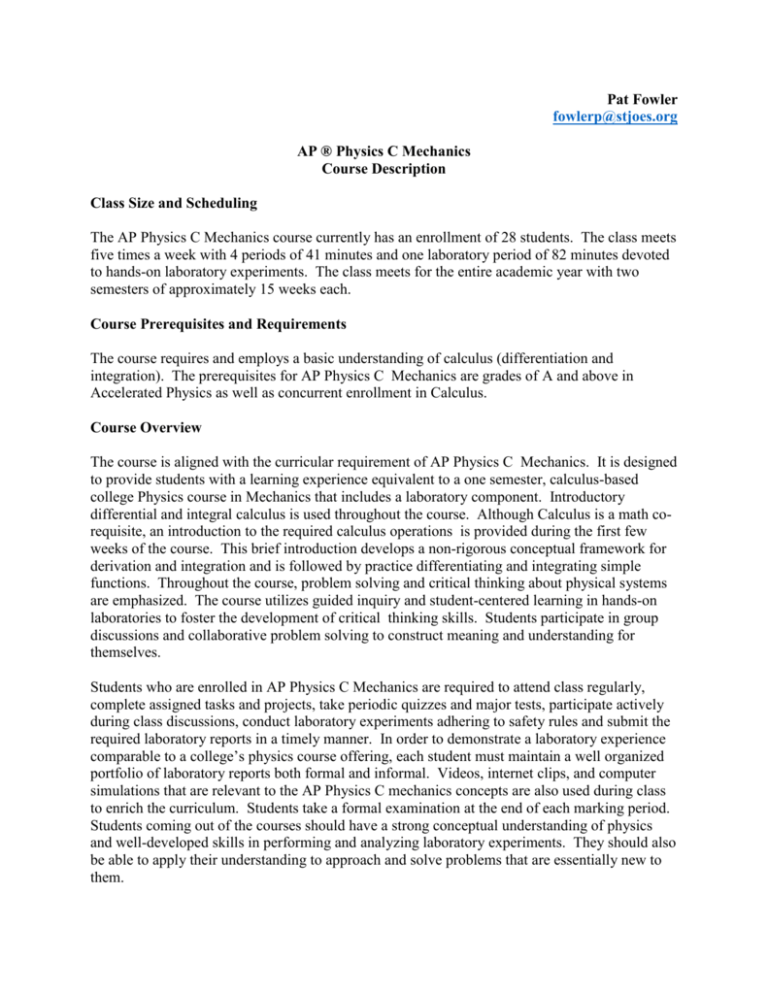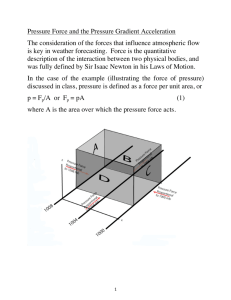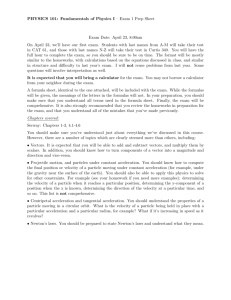
Pat Fowler
fowlerp@stjoes.org
AP ® Physics C Mechanics
Course Description
Class Size and Scheduling
The AP Physics C Mechanics course currently has an enrollment of 28 students. The class meets
five times a week with 4 periods of 41 minutes and one laboratory period of 82 minutes devoted
to hands-on laboratory experiments. The class meets for the entire academic year with two
semesters of approximately 15 weeks each.
Course Prerequisites and Requirements
The course requires and employs a basic understanding of calculus (differentiation and
integration). The prerequisites for AP Physics C Mechanics are grades of A and above in
Accelerated Physics as well as concurrent enrollment in Calculus.
Course Overview
The course is aligned with the curricular requirement of AP Physics C Mechanics. It is designed
to provide students with a learning experience equivalent to a one semester, calculus-based
college Physics course in Mechanics that includes a laboratory component. Introductory
differential and integral calculus is used throughout the course. Although Calculus is a math corequisite, an introduction to the required calculus operations is provided during the first few
weeks of the course. This brief introduction develops a non-rigorous conceptual framework for
derivation and integration and is followed by practice differentiating and integrating simple
functions. Throughout the course, problem solving and critical thinking about physical systems
are emphasized. The course utilizes guided inquiry and student-centered learning in hands-on
laboratories to foster the development of critical thinking skills. Students participate in group
discussions and collaborative problem solving to construct meaning and understanding for
themselves.
Students who are enrolled in AP Physics C Mechanics are required to attend class regularly,
complete assigned tasks and projects, take periodic quizzes and major tests, participate actively
during class discussions, conduct laboratory experiments adhering to safety rules and submit the
required laboratory reports in a timely manner. In order to demonstrate a laboratory experience
comparable to a college’s physics course offering, each student must maintain a well organized
portfolio of laboratory reports both formal and informal. Videos, internet clips, and computer
simulations that are relevant to the AP Physics C mechanics concepts are also used during class
to enrich the curriculum. Students take a formal examination at the end of each marking period.
Students coming out of the courses should have a strong conceptual understanding of physics
and well-developed skills in performing and analyzing laboratory experiments. They should also
be able to apply their understanding to approach and solve problems that are essentially new to
them.
Textbooks
Young & Freedman. Sears and Zemansky University Physics with Modern Physics 11th
edition.
Kelley, Michael (2006) The Complete Idiot's Guide to Calculus, 2nd Edition. New York, NY:
Penguin Group (to introduce differential and integral calculus)
Modeling Activities are introduced by teacher’s notes.
Laboratory
Laboratory experiences include experiments from lab manuals, data sets, internet sources, and
student-designed experiments. Students work in collaborative small groups to conduct hands-on
laboratory experiments. When possible, labs begin as a problem for which the students must
propose and develop their own procedure. They then conduct an experiment to test their ideas,
make observations, collect data, analyze the data and form conclusions based on their
observations and results. They may also apply lab concepts to new problem situations.
Each student is required to maintain a well organized AP Physics C: Mechanics portfolio of
laboratory experiments of sufficient quality and quantity to present to a college for academic
credit. Each student must write an individual lab report which is graded and kept in the
portfolio. Laboratory experiments are listed in the Labs and Activities section below.
Course Outline
First Semester
Math Review and Introduction to Differential & Integral Calculus
Conceptual Framework for derivatives (slope) and integrals (area)
Followed by practice with simple functions
2 weeks
Chapter 1 : Units, Physical Quantities and Vectors
1 week
Units and Measurements; Unit Conversion, Significant Figures, Uncertainty, Estimates,
Dimensional Analysis, and Vector basics.
Chapter 2: Motion Along a Straight Line
Displacement, Velocity and Acceleration;
1-D Motion with Constant Acceleration;
Freely Falling Objects; and Kinematic Equations
derived from Calculus. Changing acceleration (requires calculus)
2 weeks
Chapter 3: Kinematics : Motion in Two or Three Dimensions
Displacement, Velocity and Acceleration Vectors;
2-D Motion with Constant Acceleration;
2 weeks
Projectile Motion; Motion in a Circle, and Relative Velocity
Chapter 4: Newton’s Laws of Motion
Force and Interactions; Newton’s Three Laws of
Motion; Mass and Weight; Free-Body Diagrams
2 weeks
Chapter 5: Applying Newton’s Laws
N1L Particles in Equilibrium; Newton’s Second Law
Dynamics of Particles; Dynamics of
Circular Motion; Frictional Forces.
2 weeks
Chapter 6: Work and Kinetic Energy
Work; the Work-Energy Theorem;
Work Done by a Varying Force;
Power
2 weeks
Chapter 7: Potential Energy and Energy Conservation
Gravitational Potential Energy;
Elastic Potential Energy;
Conservative & Non-Conservative Forces;
Forces & Potential Energy;
Energy Diagrams
2 weeks
Second Semester
Chapter 8: Momentum, Impulse and Collisions
Impulse and Momentum;
Conservation of Linear Momentum;
Collisions: Elastic and Inelastic;
Center of Mass; Motion of a System of Particles;
Rocket Propulsion
2 weeks
Chapter 9: Rotational Kinematics
Angular Displacement, Velocity and Acceleration;
Rotation with Constant Angular Acceleration;
Angular and Linear Kinematics;
Energy in Rotational Motion; Parallel Axis Theorem;
Moment of Inertia
2 weeks
Chapter 10: Dynamics of Rotational Motion
Torque; Torque and Angular Acceleration for a Rigid Body;
Moment of Inertia and Torque;
Rigid Body Rotation about a Moving Axis;
Work and Power in Rotational Motion;
Angular Momentum;
Conservation of Angular Momentum;
Gyroscopes and Precession
2 weeks
Chapter 11: Equilibrium and Elasticity Translational & Rotational
The Conditions for Equilibrium; Center of Gravity;
Solving Rigid-Body Equilibrium Problems;
Stress, Strain and Elastic Moduli;
Elasticity and Plasticity
2 weeks
Chapter 12: Gravitation and Newton’s Synthesis
Newton’s Law of Universal Gravitation; Weight;
Gravitational Potential Energy; Satellites;
Kepler’s Laws
1 week
Chapter 13: Periodic Motion
Describing Oscillation; Simple Harmonic Motion;
Energy in the Simple Harmonic Motion;
Applications of Simple Harmonic Motion;
The Simple Pendulum; The Physical Pendulum;
Damped Oscillations; Forced Oscillations and Resonance
2 weeks
AP PHYSICS C MECHANICS EXAM REVIEW
2 weeks
Labs and Activities
Physics Laboratory Policy;
Laboratory Safety Rules.
Analysis of an Experiment: Introduction to graphing techniques to derive an equation relating
experimental quantities.
Prediction and reproduction of kinematics graphs with motion detector.
Constant Speed:
Measure distance and time of moving object, and graphically analyze its motion.
Motion with Uniform Acceleration:
Data gathered to produce a v versus t graph. This covers slope-differential and area-integral
concepts.
Acceleration due to gravity (g) is found using dot timers:
Displacement, velocity, and acceleration are manually graphed and correlated to differentiation
and integration concepts. Data is then graphed in Excel with an introduction to least squares fit
(Trend-line).
Reaction Time:
To derive and use a uniform linear acceleration equation to measure human reaction time.
Determination of Acceleration Due to Gravity with motion detector
Projectile Motion:
Calculate muzzle velocity of horizontal dart gun; Predict, then measure range when changing
vertical height. Predict, and then measure range at zero height and varying angles
Projectile Motion:
Predict the landing spot of a projectile launched horizontally from an elevated platform. Plot a
graph of horizontal range versus launch velocity
Friction:
To determine the coefficients of friction µs and µk acting between two bodies (blocks on ramp).
Newton’s Second Law of Motion:
To determine experimentally the relationship between force, acceleration and mass.
The Atwood Machine:
To study Newton’s 2nd Law by the use of the Atwood’s Machine.
Centripetal Force:
To determine the relationship between the centripetal force and the frequency of rotation.
Power Run:
To calculate the power generated by people running up stairs.
Changes in Potential Energy:
Energy exchanges in a spring-mass system: A relationship is determined between the area of an
F versus x graph and potential energy integral.
Static Torque Balance Lab:
Place weights at various places on a balanced meter stick; Place a weight to return to static
equilibrium; Derive center of mass using calculus
Torque:
To measure the acceleration caused by an unbalanced torque.
Center of Mass:
To Locate the Center of Mass of flat discs of various sizes.
Rotational Inertia:
The Relationship between Torque, Angular Acceleration and Moment of Inertia.
Forces in Two Dimensions:
To determine how to balance three forces so they are in equilibrium, calculate & combine
components forces.
Statics Lab:
Build various stable simple structures with rods and strings. Measure forces and confirm by
calculation
Hooke’s Law Lab:
Extension of steel springs and elastic bungees
Series and Parallel Springs
Vibrational Motion of a Spring:
To verify the law of simple harmonic motion for the spring.
The Simple Pendulum:
To explore the factors that determine the period of the pendulum and to determine the
acceleration due to gravity, g.
Teaching Strategies
Critical thinking is a major component of this course. During class discussions, students are
encouraged to construct meanings and understandings for themselves. Students become active
participants and engage in critical discourse. Together, they collaboratively brainstorm solutions
to free response problems. Open discussions enable me to know what is going on in the minds
of my students and encourages them to think critically and evaluate one another’s responses. For
most labs, students themselves decide on the relevant parameters to measure and control. To the
extent possible, they plan and carry out the experiments themselves. The self-structured
laboratories encourage students to analyze, synthesize, evaluate, interpret, apply, and review
data, issues or problems as it relates to their learning. Numerous discussions about the labs and
class work provide students the opportunity to develop the critical thinking, communication, and
mathematical skills required for successful problem solving. Furthermore, our decision to devote
a full year to AP Physics C: Mechanics allows time for the students to develop an in-depth
exploration of Mechanics and a laboratory experience that is comparable to a college course.
The large number and variety of labs create a portfolio that they can present to the college as
evidence of a thorough understanding of the skills and concepts of Mechanics.
Course Evaluation
Students’ final grades depend on the scores they earn from their class work, labs, portfolio,
homework, quizzes and tests. Class work includes short quizzes given once a week. In addition,
students are assigned free-response type problems regularly to solve in class. Tests are given
after every chapter. The construction of the tests resemble the AP Physics C Mechanics Exam.
Each consists of 10 multiple-choice questions and a multipart free-response question. A sheet
consisting of equations and formulas is provided on all quizzes. Emphasis in the course is
placed on developing concepts and problem-solving strategies, not on memorization. The
multiple-choice questions are derived from many sources, such as the text question bank, AP
Released Exams, The Princeton Review Cracking the AP Physics book, NJ Science League
questions and teacher’s questions. The free-response questions are generally modified AP Exam
questions and are evaluated using a rubric similar to those used to score the free-response
questions on the AP Exam.
Students’ final grade will be based on the following:
Quizzes 18%
Homework 18%
Project (Lab) 18%
Tests 36%
Mid Term 10%
Supplementary Textbooks and On-Line Resources
Giancoli, Douglas C. (2005). Physics: 6th edition. Pearson/Prentice Hall.
Boyle, Joseph. Student Study Guide and Selected Solutions Sixth Edition PHYSICS
GIANCOLI. Pearson/Prentice Hall.
Fundamentals of Physics I by Yale-University on-line support
https://itunes.apple.com/us/course/fundamentals-of-physics-i/id895182364#
Khan Academy, https://www.khanacademy.org/math/differential-calculus
https://www.khanacademy.org/math/integral-calculus







